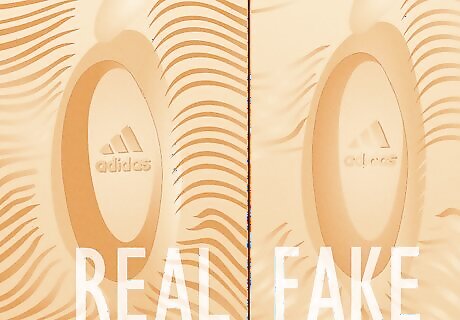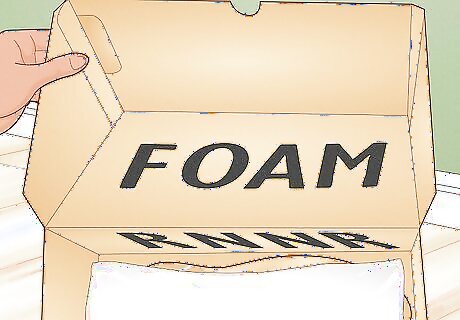
views
- Fake Foam Runners often feel like plastic and are easier to bend than real ones.
- Real Foam Runners have sharp, clean edges around the holes, while fake pairs often have material left around and between the holes.
- The shoe size and “FOAM RNNR” are clearly engraved inside real Yeezys, while this information is usually blurry, less indented, and close together on fake pairs.
Material

Fake Foam Runners are less durable and harder to the touch. Feel, squish, and bend your Foam Runners. Fake Yeezys often feel hard and plasticky. They’re also usually easy to bend in half or twist out of shape. Real Foam Runners are structured but have a bit of give when you bend them. They are also made out of a high-quality soft foam material. Real Foam Runners have a distinct, slightly grainy texture all over the shoe. Fake pairs don’t duplicate this texture well and are smooth to the touch. You typically see obvious creasing and wrinkles on fake Foam Runners after you bend them, while the real deal maintains its shape.
Toe Box

Real Foam Runners have a slightly narrow and pointed-toe box. Check the shape of the front of your shoe, which is also called the toe box. Authentic Foam Runners taper off towards the front and come to a slight point at the end. On Foam Runner dupes, the toe box tends to be wider, more rounded than pointed, and has less of a tapered end. The holes towards the front of the toe box also tend to be more narrow and less defined on fake Foam Runners than on real ones.
Heel

Foam Runner dupes have a narrower, less rounded heel. Examine the shape of the back of your shoe, looking at the curve of the heel. On fake Foam Runners, the heel is often narrower and less protruding or curved than on an authentic pair. If your Foam Runners are real, you’ll have a heel that is bulbous and makes the back of the shoe much taller and wider than the front.
Hole Patterns

Fake shoes often have misshapen holes that aren’t perfectly cut out. Look closely at the hole patterns on your Foam Runners. A fake pair usually has bits of material left around the cutout of the hole while a real pair has pristine edges. Fake Foam Runners also have holes on the top and sides of the shoe that are too narrow or round compared to a real pair. Compare your pair of shoes to a real pair to check the placement of the holes, too. While dupes have gotten better, they sometimes forget to add the large middle hole on the sides of the shoes.
Shoe Opening

Real Foam Runners have a smaller, more structured foot opening. Take a look at how the opening of the shoe stands on its own and how it feels around your ankle. On real Foam Runners, the opening holds its shape and fits snugly and comfortably around your foot. The openings on fake pairs are often unstructured, squiggly looking, and larger than real pairs. The collar on real Foam Runners, which is the portion of the shoe that hugs the back of your ankle, is usually taller and narrower than on Foam Runner dupes.
Soles

Fake Foam Runners have less defined treads on the soles. Flip over your shoes to inspect the bottoms. While dupes often have a similar pattern to real Foam Runners, the striped treads and irregular holes on the bottom of the shoe aren’t as deep or defined. If your shoes are fake, the indents typically look unclear or blurry.
Information Inside the Shoe

The sizing and manufacturing info is printed clearly on real shoes. Check out the writing on the inside of your shoe on the front, right side. Real pairs have clear, evenly spaced writing stating “FOAM RNNR,” your shoe size, and “MADE IN CHINA.” Fake pairs might not have that exact information. They also don’t have as deep engravings and often run the letters and numbers together.
Adidas Logo

Inauthentic shoes have a misshapen and poorly printed Adidas logo. Turn your shoe over and look for the Adidas logo printed inside the hole at the back of your shoe. On real Foam Runners, the Adidas logo is deeply and neatly engraved. Fake pairs usually don’t get the details right, making the logo crooked or too large. It is also not printed as deeply and looks smudged. All real Foam Runners have the Adidas logo on the bottom of the shoe, so if your pair doesn’t have it at all, it’s fake. Sometimes, Foam Runner dupes print the Adidas logo on the back of the shoe, which is a clear sign they’re fake. Real Foam Runners only place the Adidas logo on the bottom of the shoe.
Color

Fake Foam Runners are often duller or less vibrant. Compare the color of your pair of Foam Runners to a real pair. Dupes can’t quite capture the richness of a real pair, appearing pale or dull in comparison. On marbled colorways like MX Sand Gray, a fake pair doesn’t have the same patterning and typically uses more of 1 color than the real pair. Yeezy Foam Runners come in neutrals except for the bright red Vermillion colorway. If your pair is super colorful, they’re fake. Currently, the Foam Runners come in Ararat, Onyx, Mineral Blue, Desert Sand, Sulfur, Mist, Sand, Ochre, Stone Sage, Clay Taupe, Flax, Vermillion, MX Carbon, MX Sand Gray, MX Cream Clay, and MX Moon Gray.
Box and Packaging

Real Foam Runners come in a cardboard box with “FOAM RNNR” inside. Inspect how your shoes arrived in the mail and what’s printed inside the box. Authentic shoes come in a smooth box with “FOAM” printed inside the top and “RNNR” on the side below it. On the bottom of the box is a sticker with “YZY FOAM RNNR” printed above it and “MADE BY ADIDAS” with the Adidas logo under it. Shine a blacklight on the box to look for hidden stamps, which indicate that the shoes are fake. Fake pairs of shoes might have larger “FOAM RNNR” lettering that takes up the entire top of the box. Even if your box looks authentic, there’s a possibility that the shoes are dupes sold in a legitimate box. So, make sure to inspect your shoes thoroughly to determine if they’re real. Depending on where you live, the box might say “FOAM RNR” instead.
Barcodes and Stickers

Foam Runner dupes have poor letter spacing and use fake barcodes. Look in the bottom of your box for a sticker with “YZY FOAM RUNNER” on top, the size on the left, and the color of the shoes abbreviated instead of fully written out. Then, look up the barcode number on the outside and inside of the box online. If the search results pull up your same shoes or legitimate websites like StockX, your shoes are likely real. Make sure the shoe information matches the information on the stickers. If they don’t, this is a sign the box or shoes are fake. Fakes often space the words on the stickers too close together. In real boxes, the line separating the sizing is typically at the “O” in FOAM” and all the words are spaced away from the sticker’s edges. Dupes might also misspell or forget to add words on the sticker, such as “MADE CHINA” instead of “MADE IN CHINA.”
Tags

Real Foam Runners have text close to the sides of the tags. Check how the shoe information is written on the tag and sticker attached to the shoes. On real shoe tags, the size information, QR code, and barcode are almost flush against the edges. Similarly, the information on the tiny sticker inside the shoe is clear, evenly spaced, and written towards the edges. Double-check that the shoe information on the tags and sticker matches the coloring and size of your shoes. If they don’t, your shoes might be fake. If your shoes are fake, the Adidas logo on the shoe sticker might be under the QR code, instead of to the left of it.




















Comments
0 comment